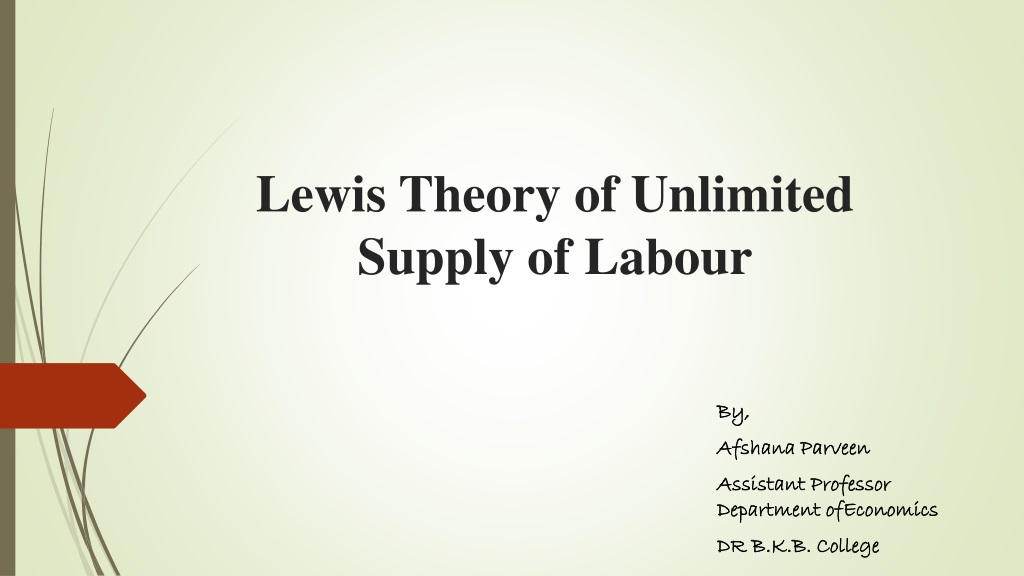

Replay
0 likes | 105 Views
Lewis theory, proposed by Prof. W. Arthur Lewis, focuses on using abundant labor in underdeveloped countries to drive economic growth through a dual economy model. The model assumes unlimited labor supply, dualistic economy structure, and capitalist surplus. It explains how surplus labor from the subsistence sector can be mobilized into the capitalist sector to create profits and further development, but also highlights criticisms and challenges such as unrealistic assumptions and one-sided perspective.

E N D
Lewis Theory of Unlimited Supply of Labour By, By, Afshana Parveen Afshana Parveen Assistant Professor Assistant Professor Department ofEconomics Department ofEconomics DR B.K.B. College DR B.K.B. College
Main points of the Model Introduction The Model Assumptions Main features of the model- a) Dual Economy b) Capitalist Surplus Diagrammatic Representation End of growth Process Criticisms Conclusion
Introduction Propounded by Prof. W.Arthur Lewis Based on unlimited supply of labour First published- Manchester School in May 1954 The Lewis Model Supply of labour based model Central Theme- since UDC are labour abundant and capital scare, so this abundant labour can be used as an engine of growth in such countries.
Assumptions Supply of labour is unlimited or perfectly elastic The economy is dualistic in nature- exists a modern capitalist sector and a rural subsistence sector The output in the subsistence sector is less than that in the capitalist sector Urban wages are higher than Rural subsistence wages Production in the capitalist sector are driven by profit motive and the capitalists reinvest all their profits.
Features of the Lewis Model Dual Dual Economy Economy- - Capitalist Sector- The capitalist sector is that sector of the economy which uses reproducible capital and pays capitalists for the use thereof. Subsistence Sector- subsistence sector is that sector of the economy which is basically agriculture based. the main problem- to provide employment to the unlimited supply of labour Can be done- establishing industries or expanding industries at existing wage rate. Mobilization of labour from subsistence to capitalists sector Drawback- expansion of capitalists sector requires only skilled manpower Quasi Drawback
Features of the Lewis Model Capitalist’s Capitalist’s Surplus Main aim is to maximise profit Capitalists surplus is the difference between the Marginal productivity of labour and capitalist wage. Labours are drawn from the subsistence sector on account of higher wages Where is the profit/surplus? High contribution to total output » capitalists surplus» reinvested» capital formation» new jobs more labours from the subsistence sector » capitalist surplus » reinvested » continues till the surplus labour is exhausted. In this way the system is brought out of underdeveloped. Surplus- -
Diagrammatic Representation OS- subsistence wage OW- capitalist’s wage WW is the perfectly elastic supply curve of labour OE1 ---- A1D1 -----OA1B1E1 OWB1E1-----wages paid to labours WA1B1------surplus output Reinvested– shift in MPL curve Higher employment> higher surplus Continue till surplus labours are exhausted Supply curve be slope upwards from left to right> employment and wages will increase.
End of Growth Process Expansion of capitalists sector will turn the terms of trade against them. They will be required to pay higher wages keeping their real income intact, thereby surplus vanishes Expansion of the capitalists sector will reduce the population in the subsistence sector increasing the productivity of labour in the subsistence sector thereby increasing wages and reducing surplus The labourers follows the capitalists way of life and agitates for higher wages thereby reducing surplus The subsistence sector might develop new technologies over time thereby reducing the capitalists surplus.
Criticisms Unrealistic Assumptions One sided Theory Migration of only unskilled labour Emphasises on investment multiplier The theory fails if new investment results in labour saving technology Migration not easy The theory still heads its head high as one of the important theories of development specially in the under developed nations where labour is abundant and capital is scarce
